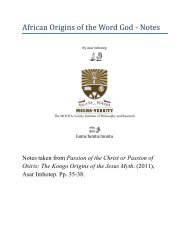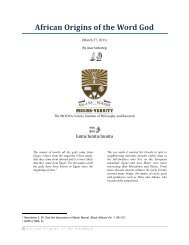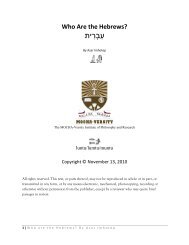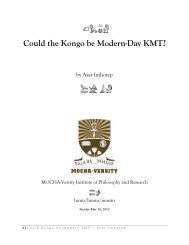reinterpretations of the ankh symbol part 2 - Asar Imhotep
reinterpretations of the ankh symbol part 2 - Asar Imhotep
reinterpretations of the ankh symbol part 2 - Asar Imhotep
Create successful ePaper yourself
Turn your PDF publications into a flip-book with our unique Google optimized e-Paper software.
12<br />
<strong>of</strong> <strong>the</strong> blood (Egyptian snfw “blood”) with an affiliated removal <strong>of</strong> carbon dioxide and o<strong>the</strong>r<br />
gaseous metabolic wastes from <strong>the</strong> circulation. As gas exchange occurs, <strong>the</strong> acid-base balance <strong>of</strong> <strong>the</strong><br />
body is maintained as <strong>part</strong> <strong>of</strong> homeostasis. If proper ventilation is not maintained, two opposing<br />
conditions could occur: respiratory acidosis, a life threatening condition, and respiratory alkalosis.<br />
The Ebers Medical Papyrus (1557-1530 BCE) informs us that <strong>the</strong> ancient Egyptians were very<br />
familiar with <strong>the</strong> circulatory system, its importance and its proper functional characteristics. 6 For<br />
instance (pEbers 99, 1-12):<br />
hAt-a m sStA n swnw<br />
Introduction to <strong>the</strong> secret lore <strong>of</strong> <strong>the</strong> doctor<br />
rx Smt hAty rx HAty<br />
Knowledge <strong>of</strong> <strong>the</strong> heart’s movement, and <strong>of</strong> <strong>the</strong> heart.<br />
iw mtw im.f n at nbt<br />
There are vessels inside it leading to each member.<br />
ir nw rdiw swnw nb sxmt-wab nb sAw nb<br />
Thus, when any doctor, surgeon (literally, priest <strong>of</strong> Sekhmet), or exorcist<br />
awy dbaw.f Hr tp<br />
places his hands or fingers on <strong>the</strong> head,<br />
Hr mkHA Hr drwt hr st ib<br />
on <strong>the</strong> back <strong>of</strong> <strong>the</strong> head, on <strong>the</strong> hands, on <strong>the</strong> position <strong>of</strong> <strong>the</strong> heart itself<br />
Hr awy Hr rdwy nb<br />
on <strong>the</strong> limbs or on any o<strong>the</strong>r <strong>part</strong>,<br />
xAi.f n HAty<br />
in so doing he in fact examines <strong>the</strong> heart,<br />
Hr ntt mtw.f n at.f nbt<br />
because <strong>the</strong> heart’s vessels lead to each <strong>of</strong> <strong>the</strong> (patient’s) members;<br />
nt pw mdw.f xnt mtw nw at nbt<br />
in o<strong>the</strong>r words, <strong>the</strong> heart speaks within <strong>the</strong> vessels <strong>of</strong> each member 7<br />
The Papyrus Ebers is humanity’s first medical encyclopedia. In <strong>the</strong> above passage is <strong>the</strong> first<br />
historical reference for taking a pulse. This text demonstrates that <strong>the</strong> Egyptians had discovered<br />
that <strong>the</strong> heart was <strong>the</strong> main motor <strong>of</strong> <strong>the</strong> human body and it is <strong>the</strong> starting point for <strong>the</strong> irrigation <strong>of</strong><br />
<strong>the</strong> whole organism. The blood needs oxygen to help get rid <strong>of</strong> metabolic waste in <strong>the</strong> circulatory<br />
system. That’s where <strong>the</strong> processes mentioned above involving <strong>the</strong> thorax come into play. It also<br />
speaks to why we need pure oxygen in our bodies. If our air is toxic, <strong>the</strong> oxygen can’t properly<br />
cleanse our system.<br />
THE ANKH AND THE BLOOD<br />
In <strong>the</strong> upcoming publication Ogun, African Fire Philosophy and <strong>the</strong> Meaning <strong>of</strong> KMT (2011) I discuss,<br />
in <strong>part</strong>, <strong>the</strong> possible relationship between <strong>the</strong> anx <strong>symbol</strong> and <strong>the</strong> blood (so essential to life).<br />
Because it is a minor point within a larger context <strong>of</strong> <strong>the</strong> book, I will expand my initial findings here<br />
as it is even more relevant to this discourse.<br />
6 However <strong>the</strong>y considered this a one-way process.<br />
7 Cited in Obenga (2005: 371-372)






